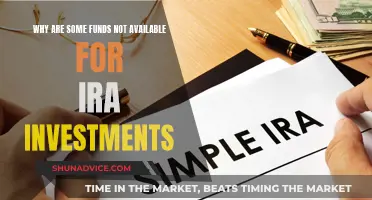
The 2017 Tax Cuts and Jobs Act established Qualified Opportunity Zones to incentivize private investment in economically distressed communities. Investors in these programs can defer and reduce their tax liability on capital gains.
Qualified Opportunity Funds (QOFs) are investment vehicles that aim to drive business and real estate investment towards low-income or economically distressed areas. Investors can reinvest any realized capital gains into these funds to defer taxes on their gains and reduce their tax bill.
QOFs facilitate investments into businesses or properties within Qualified Opportunity Zones (QOZs). States nominate low-income communities to be designated as opportunity zones, and the nomination must be certified by the U.S. Treasury Department. Once a location is selected and approved, QOFs can begin investing in properties and businesses within the opportunity zone, with the goal of making improvements.
| Characteristics | Values |
|---|---|
| Purpose | Spur economic development and job creation in distressed communities |
| Tax benefits | Deferral of capital gains tax liability, 100% tax-free gain on the investment if held to the required term |
| Investment type | Real estate or business development |
| Investment location | Low-income communities and certain neighbouring areas, defined by population census tracts |
| Investment timing | Reinvest eligible gains into a qualified opportunity fund within 180 days from when the gain would be recognized |
| Investment period | 10 years |
What You'll Learn

Tax incentives for investors
The 2017 Tax Cuts and Jobs Act established Qualified Opportunity Zones to provide tax incentives for private, long-term investment in economically distressed communities. These incentives are designed to spur economic development and job creation in these areas.
Tax Deferral
Investors can defer their tax payments on prior investment gains if those gains are then invested in a qualified opportunity fund within 180 days after the sale. Taxes are then deferred to either the day when the opportunity fund investment is sold or exchanged, or December 31, 2026—whichever comes first.
Step-up in Tax Basis
A taxpayer who defers gains through a Qualified Opportunity Fund investment receives a 10% step-up in tax basis after five years and an additional 5% step-up after seven years. Thus, to be eligible for the 15% increase in tax basis, the taxpayer needed to invest by December 31, 2021, and by December 31, 2019, for the additional 5%.
No Tax on Appreciation
If the investment in a Qualified Opportunity Fund is held for at least 10 years, the investor does not owe federal income taxes on the fund's appreciation by the date of sale. This is perhaps the most significant tax benefit of the program.
Mutual Funds: Why Officials Invest and You Should Too
You may want to see also

How to invest in a Qualified Opportunity Fund
Investing in a Qualified Opportunity Fund (QOF) can be a great way to support economic development in distressed areas while also providing tax benefits to investors. Here are the steps to invest in a Qualified Opportunity Fund:
Understand the Requirements:
Before investing, it is important to understand the criteria for Qualified Opportunity Funds. A Qualified Opportunity Fund is an investment vehicle that is organized as a corporation or partnership with the specific purpose of investing in Qualified Opportunity Zone property. The fund must hold at least 90% of its assets in Qualified Opportunity Zone property, which includes stock, partnership interests, or business property in an Opportunity Zone.
Find a Qualified Opportunity Zone:
Qualified Opportunity Zones are economically distressed communities that have been nominated by the state and certified by the Treasury Department. These zones can be found in all 50 states, Washington D.C., and U.S. territories. You can find a list of designated Qualified Opportunity Zones at the U.S. Department of Housing and Urban Development or through the IRS.
Identify Eligible Gains:
To invest in a Qualified Opportunity Fund, you need to have eligible gains to invest. Eligible gains include capital gains and qualified 1231 gains recognized for federal income tax purposes before January 1, 2027, and not from a transaction with a related person. These gains can come from the sale of appreciated assets such as real estate or stocks.
Timing of Investment:
Once you have identified your eligible gains, you have a 180-day window from the date of the sale to invest in a Qualified Opportunity Fund. This investment must be in exchange for equity interest, not debt interest. It is important to act within this timeframe to take advantage of the tax benefits offered by Qualified Opportunity Funds.
Invest in a Qualified Opportunity Fund:
When investing in a Qualified Opportunity Fund, be sure to conduct thorough due diligence. Review the fund's strategy, investment criteria, and the specific Opportunity Zone properties they invest in. Consult with your financial advisor to ensure the investment aligns with your financial goals and risk tolerance.
Understand the Tax Benefits:
Investing in a Qualified Opportunity Fund offers several tax benefits. First, you can temporarily defer taxes on your eligible gains until December 31, 2026, or when you sell or exchange your investment, whichever comes first. Second, if you hold your investment for at least 5 years, your basis will increase by 10% of the deferred gain, and an additional 5% if held for at least 7 years. Finally, if you hold your investment for at least 10 years, you may be able to permanently exclude gains from a qualifying investment when it is sold or exchanged.
Meet Reporting Requirements:
If you hold a qualifying investment in a Qualified Opportunity Fund during the tax year, you must meet annual investor reporting requirements. This includes filing Form 8997, Initial and Annual Statement of Qualified Opportunity Fund (QOF) Investments, with your federal tax return. Additionally, you may need to file Form 8949, Sales and Other Dispositions of Capital Assets, to elect the eligible gain deferral.
By following these steps, you can invest in a Qualified Opportunity Fund while also supporting economic development in distressed communities. Remember to consult with your financial and tax advisors to ensure this type of investment aligns with your specific situation and goals.
Retirement Funds: Best Indian Investment Options
You may want to see also

The benefits of investing in a Qualified Opportunity Fund
Tax Deferral and Reduction
QOFs offer investors the opportunity to defer and potentially reduce their tax liability on capital gains. By reinvesting gains from the sale of appreciated assets into a QOF within 180 days, investors can delay paying taxes on those gains until the earlier of two dates: when the QOF investment is sold or exchanged, or December 31, 2026. This provides investors with a significant tax planning tool, allowing them to potentially reduce their tax burden in the current year.
Step-up in Tax Basis
If investors hold their QOF investment for at least five years, they become eligible for a 10% step-up in tax basis. This means that 10% of the original deferred gain is excluded from taxation. If they hold the investment for at least seven years, the exclusion increases to 15%. This benefit can result in substantial tax savings, especially for those with large capital gains.
No Tax on Appreciation
One of the most significant benefits of investing in a QOF is the potential for tax-free appreciation. If investors hold their QOF investment for at least ten years, they pay no federal income taxes on the fund's appreciation when it is sold or exchanged. This means that any gains accumulated over the ten-year holding period are completely tax-exempt, providing a powerful incentive for long-term investment in economically distressed communities.
Economic Impact
QOFs are designed to spur economic development and job creation in low-income and distressed communities. By investing in these funds, individuals can contribute to the revitalization of underserved areas, promoting local business growth and creating new employment opportunities. This aspect of QOFs not only benefits the communities themselves but also aligns with the values of socially conscious investors who wish to have a positive impact with their investments.
Investment Flexibility
QOFs provide investors with flexibility in terms of the types of investments they can make. They can invest directly by holding business property within a Qualified Opportunity Zone or indirectly by acquiring stock or ownership interests in businesses located in these zones. This flexibility allows investors to diversify their portfolios while still taking advantage of the tax benefits offered by QOFs.
Cytonn Money Market Fund: Your Guide to Investing
You may want to see also

The rules and regulations for investing in a Qualified Opportunity Fund
- QOFs are investment vehicles that allow people to invest in economically distressed communities, known as "opportunity zones", that have been designated by the state and certified by the Secretary of the U.S. Treasury via the Internal Revenue Service (IRS). These zones are typically low-income areas in need of stimulus.
- To become a QOF, an eligible corporation or partnership must file IRS Form 8996 with their federal income tax return, self-certifying as a QOF.
- QOFs must invest at least 90% of their assets in designated opportunity zones to receive preferential tax treatment. These investments must be in the form of "substantial improvements" to the properties, which are defined as investments equal to the original value paid by the fund within 30 months.
- Certain types of businesses cannot be included in QOFs, even if they are located within opportunity zones. These include racetracks, gambling facilities, massage parlors, hot tub facilities, suntan facilities, and liquor stores.
- Investors can defer their tax payments on prior investment gains if those gains are then invested in a QOF within 180 days of the sale. Taxes are then deferred until either the day the QOF investment is sold or exchanged, or December 31, 2026, whichever comes first.
- The longer an investor holds their QOF investment, the smaller their tax burden may be. If held for longer than five years, investors receive a 10% exclusion of the deferred gain on their investment. If held for more than seven years, they receive a 15% exclusion. After 10 years, the investor does not owe federal income taxes on the fund's appreciation by the date of sale.
- To elect the eligible gain deferral, investors must invest the eligible gain in exchange for an equity interest in the QOF. They can then elect the deferral on Form 8949 for the taxable year in which the gain would be recognized if it hadn't been deferred. Form 8997 must also be completed and submitted.
- An inclusion event, which generally refers to an event that reduces or terminates an investor's qualifying investment in a QOF, ends the deferral period. This includes sales, gifts, or liquidation of the QOF.
- Investors must meet annual reporting requirements if they hold a qualifying investment in a QOF at any point during the tax year. Form 8997 must be filed annually with the investor's federal tax return.
Structuring Sustainable Investment Funds: Strategies for Long-Term Success
You may want to see also

The impact of Qualified Opportunity Funds on economic development
Qualified Opportunity Funds (QOFs) are investment vehicles that aim to drive business and real estate investment towards economically distressed areas. The 2017 Tax Cuts and Jobs Act established a tax rule that incentivizes investors to reinvest their capital gains into QOFs by offering preferential tax treatment. This program was designed to stimulate economic growth and job creation in these communities.
To qualify for preferential tax treatment, a QOF must invest at least 90% of its assets in Qualified Opportunity Zone properties and businesses. These zones are identified by state, county, and census tract numbers, and there are currently 8,741 of them across the US, including Washington, D.C., and US territories.
By investing in these funds, individuals can defer their capital gains taxes and, ultimately, reduce their tax bill. The longer the investment is held, the greater the tax benefit. For instance, if an investment is held for more than five years, investors receive a 10% exclusion on their deferred gain. This exclusion increases to 15% if the investment is held for more than seven years. If the investment is held for over 10 years, investors won't owe any capital gains taxes on the fund's appreciation.
The funds raised through QOFs are intended to be used for substantial improvements to properties within the Qualified Opportunity Zones. For example, if a QOF purchases a building for $1 million, they have 30 months to make a minimum of $1 million worth of improvements to that building.
The impact of QOFs on economic development is twofold. Firstly, they provide tax benefits to investors, encouraging them to invest in distressed areas. Secondly, the funds are intended to propel economic growth through job creation, business activity, and expanded housing options in these communities.
However, the effectiveness of QOFs in stimulating economic development is debated. While the White House Council of Economic Advisors found that QOFs raised $75 billion in private investment by the end of 2019, which could reduce poverty in opportunity zones by 11%, a 2020 study by the Urban Institute suggested that the capital often benefits real estate developers rather than the areas with the greatest need.
A Global Investor's Guide: Foreign Index Funds
You may want to see also
Frequently asked questions
A QOZ is an economically distressed community where new investments, under certain conditions, may be eligible for preferential tax treatment. Localities qualify as QOZs if they were nominated for that designation by a state, the District of Columbia, or a U.S. territory and that nomination was certified by the Secretary of the U.S. Treasury via his delegation of authority to the Internal Revenue Service (IRS).
To invest in a QOZ, you must first identify a Qualified Opportunity Fund (QOF) that is accepting investment capital. A QOF is an investment vehicle structured as a REIT or partnership with the specific objective of investing in opportunity zone assets. Once you have identified a QOF, you must invest your capital gains into the fund within 180 days of triggering the capital gain. The fund will then use your investment to purchase properties within an opportunity zone.
By investing in a QOZ, you can defer and potentially reduce your tax liability on capital gains. If you hold your investment for at least 5 years, there is a 10% exclusion of the deferred gain. If held for at least 7 years, the 10% exclusion becomes 15%. If you hold your investment for at least 10 years, you will not owe capital gains on any additional appreciation beyond what you paid in 2027.
As with any investment, there are risks involved when investing in a QOZ. Similar to other investments, the risks may include market loss, liquidity risk, and business risk, among others. Additionally, there are specific rules and regulations that must be followed to qualify for the tax benefits, and these rules may change over time. Therefore, it is important to consult with a tax or financial advisor before investing in a QOZ.







